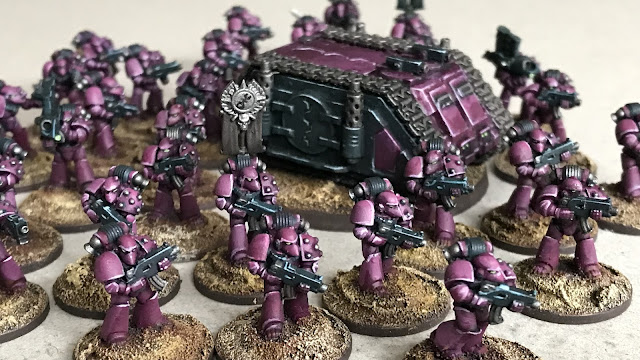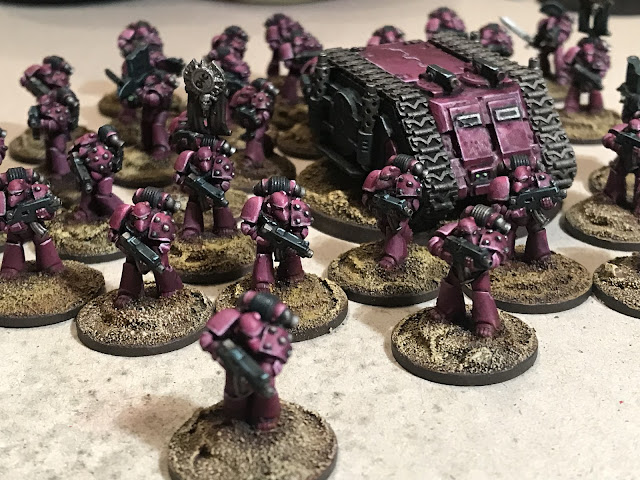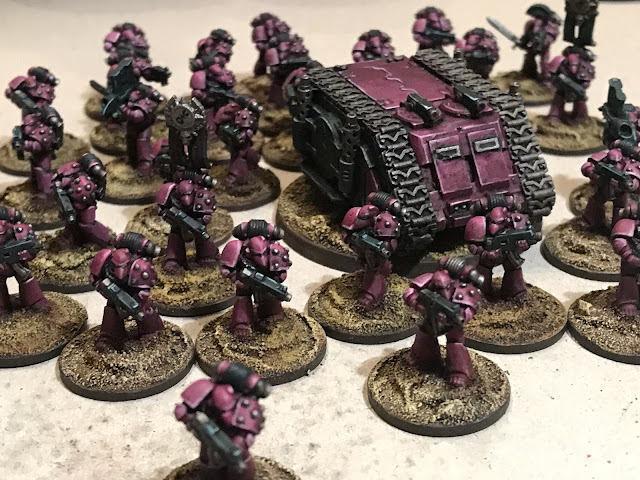+ Leagues of Votann +
Squats are back... or have the Warhammer dwarfs made their way into the 41st Millennium? Or are the Leagues of Votann something else entirely?
This inload muses on the way that GW are approaching the Leagues, and how they relate to the Squats and other Dwarfs in Warhammer. Thought I'd throw it up here to hear your thoughts (and show off some of my dwarf models!).
+ Aesthetics of the League of Votann +
Anecdotally (that is, from what I've read here and on similar online spaces) the reaction to the aesthetic of the Leagues of Votann has struck me as mixed rather than actively hostile or frothingly enthusiastic (though there are obviously exceptions to this). Although a lukewarm or hesitant reaction might seem a bit of a downer, I think that's actually a pretty good result for GW, I think. Familiarity breeds positivity, and the previews have been met with (again, anecdotally) less vehement opposition than the Tau did when they were introduced.
I don't want to dwell too much on this, as I want to discuss archetypes, but wanted to head off too much discussion on the aesthetics except where they relate to archetypes – or in other words, how they relate to what we (as painters, gamers and collectors) expect.
+++
+ Dwarfish archetypes +
Dwarfs of one sort of another pop up in folklore all across the world, but I think it's fair to say that Warhammer dwarfs mostly draw from a well filled by the European tradition of dwarfs as small, cunning cthonic spirits – ugly craftsmen elves. Perhaps the clearest and most direct inspiration for the old Warhammer dwarfs are Tolkein's dwarves. European folklore is surprisingly flexible on what makes a dwarf; some were implied to be larger than humans, for example, or more akin to what we'd probably now call 'spirits of earth', rather than physical creatures.
 |
| + Burly, heavily armoured fantasy Dark Age warriors – who happen to be short + |
What we – that is, inloaders here and hobbyists more generally – expect from dwarfs is likely coloured, particularly by Warhammer Dwarfs. A lot of the established imagery has been gradually refined for the past hundred years or so, until nowadays I think you could probably ask pretty much anyone, young or old, to draw a 'fantasy dwarf' and get something fairly similar: small, short-limbed, probably bearded.
For anyone with a deeper interest in fantasy – be it literature, roleplaying or folklore – I think you could probably refine this to include a gruff, perhaps short-tempered character; greedy and avaricious, with a deep reverence for riddles and rules. They might swindle you, but they'll follow the letter of the law while they do so.
Beyond this, the common archetypes become more refined and specific; less useful in analysing 'dwarfishness', but better for creating something with its own identify and character. What I'd like to discuss is:
- Are there more archetypes? What makes a dwarf a dwarf?
- How do the Leagues of Votann relate to these?
- Is it a good thing for them to be distinct from the Squats?
+++
+ What makes a dwarf a dwarf? Archetypes and peripherals +
I'd argue that all of Games Workshop's dwarfs stem from Tolkein first and foremost. The dwarfs of the Old World show this most clearly. Starting out as essentially 'expys', they gradually developed their own character, but less so than (say) Warhammer Orcs. Dwarfs from the Warhammer world were reliable (to a fault), honour-bound, deeply respectful of age and tradition. They were master craftsmen, intelligent (but not necessarily wise), secretive and defensive in nature, and well-equipped and armoured. Physically, they were short, but stocky; tough and enduring and slow. These are (some of) the refined archetypes of the Warhammer dwarfs.
 |
| + Warhammer Dwarfs – stoic, stolid, (dare I say?) doughty. And with more than a few beards, pipes and tankards of beer scattered about. + |
Many of the other aspects that I associate with dwarfs – beards, underground fortresses, a longing for a past golden age, axes, beer, hatred of elves and greenskins, distrust of magic, etc. – stem from these, but I think they're more peripheral than the core archetypes above. (I'm open to discussion on that, of course!) I'll call these 'peripherals' in the rest of this post.
The distinction between archetypes and peripherals is simple – but I hasten to add that much of my list is purely personal. Beards, for example, seem to have popped up in discussion so much as 'core to dwarfs' that it's very easy to argue they're archetypal. I'd very mcuh like to hear your thoughts.
Why's this important? Well, consider the other Dwarfs of Warhammer – the Chaos Dwarfs and (to a lesser extent) the Norse Dwarfs and Blood Bowl Dwarfs. All Warhammer dwarfs shared the archetypes listed, but the peripherals varied somewhat.
+++
When it came to developing the Squats in 40k, I think many of the core archetypes got a bit muddled, and I wonder if that's why the GW studio ultimately felt a bit hampered in not knowing where to take them. Where the Old World dwarfs had a firm anchor, the squats were a bit torn between their inherent 'conservative scepticism' and the need to do something new. Lots of peripherals were bolted on – the bikes, for example – but the peripherals were torn between pseudo-Tolkein anglo-saxon/norse, greasy-leathered bikers and short Imperial Guardsmen.
Epic seemed to grasp the archetypes a bit better – perhaps because ancient, slow, tough super-heavy vehicles are a good analogue of many of the archetypical elements: essentially beautifully-crafted mobile fortresses. Here, the biker guilds were less obviously distinct – the scale making the aesthetics less jarring – and so the range held together well.
When 2nd edition 40k rolled round, the few previewed 40k-scale squats seemed to have stabilised a bit, refining the angle pioneered by Epic, and leaning back towards the Anglo-Saxon/Norse vibes and away from outlaw bikers – in short, getting closer to the Warhammer dwarf archetypes listed above. Whether this would have turned things around was never to be determined, of course, as the faction faded away.
+++
+ Age of Sigmar and dwarfs +
Age of Sigmar saw a real shaking up of the factions, with many factions taking a deliberate step away from the peripherals of their previous incarnations. This was, to my mind at least, a positive thing. While I very much like the Old World aesthetic, it was ultimately reductive. The accretion of years of real world development (and peripheral additions) had painted the world into a (very cool) corner that made expansion difficult.
At the root of this discussion is my claim that the peripherals make sense because of the archetypes, whereas the archetypes make sense because they're culturally familiar. To take Warhammer trollslayers as an example, they build on the cultural pressures facing Warhammer Dwarfs specifically: in a world of ultra-reactionary traditionalism and a culture of honour and oaths, if something dishonourable happens, there's no way out for a dwarf. The solution? The ultra-specific trollslayer peripheral concept.
That peripheral concept doesn't work quite so well if stripped out of its archetypal context, and I think that's part of why the first Age of Sigmar dwarfs – the Fyreslayers – had (again, anecdotally) a similar lukewarm reaction among the fanbase as the Leagues of Votann are receiving. With the benefit of ten years of hindsight, and with the Age of Sigmar setting built up around them, I think the Fyreslayers have actually made clearer a lot of the links to the archetypes – and that's something that I think GW are doing a bit better with the Leagues of Votann, 'preparing the ground' with lore previews.
 |
| + I converted these Fyreslayers to better fit my preferred aesthetic – but I'm glad there are multiple options for people to choose from. + |
Compare the reception the Fyreslayers had with the Kharadon Overlords. The latter took a very different spin on the common archetypes, presenting us with a Ghibli-esque art-deco steampunk aesthetic. On the one hand, that's quite a bold change – but on the other it actually hews very closely to the archetypes. I'd argue that the Kharadon Overlords, while being visually quite radically different from the Dwarfs of the Old World, better captured the list of archetypes below than the Fyreslayers did on release:
'reliable (to a fault), honour-bound, deeply respectful of age and tradition. They were master craftsmen, intelligent (but not necessarily wise), secretive and defensive in nature, and well-equipped and armoured. Physically, they were short, but stocky; tough and enduring and slow.'
To me this suggests that the Leagues of Votann are more likely to get a positive reception if they manage to hit the list of archetypes relates to Warhammer dwarfs, rather than being an update of the rather muddled Squats. Note that this is largely separate from the aesthetics, as I note at the start. There's overlap, sure, but I want to avoid conflating the core underlying concepts (i.e. the direction GW are taking) with the reflection of those concepts (i.e. how that's shown in the models) – there's a separate topic for that, and how successfully that's achieved.
+++
+ ...And back to the Leagues of Votann +
Thanks to the GW previews, we're starting to get a good idea of how the Leagues range is going to look as a whole. Right at the start of this diatribe post I said that the reaction to the Leagues aesthetic was mixed, but also that that wasn't necessarily a bad thing. Here, I'd like to draw some lines between what we've seen thus far, and how they relate to my list of archetypes above:
- The Votann themselves – I think these are a brillant sci-fi re-imagining of lots of the Warhammer dwarf archetypes, touching on veneration of age and secrecy, and crafting ability. I also think the fact that they're slowly failing is a good peripheral narrative angle for the faction. It's also a fantastic exploration of 'intelligent, but not necessarily wise'. The Votann have the semi-mythical feel of
- The Hearthkyn and Hearthguard warriors – definitely hit the 'well-equipped and armoured' angle, and also hit the physical archetypes for me.
- The Ironkyn are a nice nod to master crafting, and more deeply, I think that they reflect the 'magical craftsmen' concept of older dwarf archetypes too – the sort of dwarfs that make magic items for gods. It's a nice twist to have what are 'far future' concepts to us be 'ancient history' to the Leagues.
- Hernkyn Pioneer – to me, this is slightly at odds with the 'defensive' and 'slow' archetypes that I suggested above, but does hit the crafting angle, if only obliquely.
- The Sagitaur better interprets the archetype of 'defensiveness', being a well-armed transport that's rugged and reliable.
Overall, I think the things we're missing, or are less obvious from the list are more about character: reliability, cunningness, honour-bound and intelligent. These are aspects that I'm hoping are explored a bit more in the lore and particularly in the Codex. I'd like to hear how the Leagues relate to the other xenos – while it's peripheral (I'd argue) that dwarfs hate elves and greenskins, it's an angle that was front and centre for the Squats.
This is what's most exciting me at the moment about the Leagues – how closely will they hew to the Warhammer Dwarf archetypes above, how will they explore and expand on that to make a unique creation – and what, if anything, will they draw from the Squats?
+++
+ Conclusions +
So, the ideas are laid out above. I'm very happy to discuss whether my list of archetypes is too broad, or too narrow – or even misses the point – but I hope that it provides a good place to start discussions on what you consider core to the idea of space dwarfs, and what you'd like GW to be more exploratory with. Most importantly, what you'll do with the models GW are presenting to us. :)













